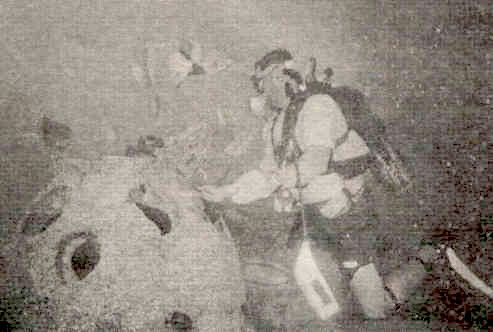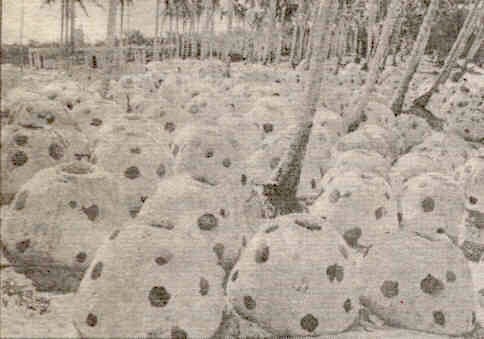<=Back
FLAGPOLE
October 14, 1998
AN ANTIDOTE TO REEFER MADNESS
Athens' contribution to the fight to save coral reefs
In this UN-declared "International Year of the Ocean." it
would appear that one of man's strongest weapons in preserving coral reefs is an enormous
lump of Swiss-cheesy concrete. It's a Reef Ball, or an artificial coral reef built to
imitate the real thing as the real thing becomes harder and harder to find.
The name is weird, admits local musician Kathy Kirbo, who serves as executive director of
the Reef Ball Foundation, Inc. "People either think of RuPaul or pot," she says.
Despite the name, Reef Ball has evolved from its conception in Athens and Atlanta to
become a global player in the preservation of coral reefs.

The man behind the ball is Todd Barber. When Barber, 35, founded the
Reef Ball Development Group (RBDG) in 1993, he employed his scuba diving friends he met at
UGA, such as Kirbo. Since then, both the for-profit organization (RBDG) and the year-old
nonprofit foundation have worked with internationally diverse clients, from the Boy Scouts
of America to the governments of Qatar and Hong Kong.
When Barber met Kirbo in a scuba diving class at UGA, Kirbo was a
musician (now of Jackpot City) studying psychology and global studies, and Barber was
pursuing his business degrees. However, Barber and Kirbo shared a similar concern for the
fate of their childhood haunts, having witnessed their decimation upon return trips to
favorite diving spots. Since both received divers' certification around the same time,
(Kirbo at age 12; Barber at age 15), they knew first hand what was happening to the
reefs.
"Unless you're a diver, you don't realize how bad it's
gotten," Kirbo says.
Natural coral reefs, which take thousands of years to form, are being
destroyed at an alarming rate. Ten percent of the world's coral reefs are already
destroyed, and 70 percent could be gone in just 20 to 40 years, marine scientists say.
Reefs are threatened by not only natural disasters but also pesticide pollution and
runoff, inadequate waste water treatment, and even recklessly tossed boat anchors.

Besides supporting the major food source for people of coastal
fishing areas, providing natural sea walls against hurricanes, and preventing erosion of
coastlines by limestone deposits, coral reefs are a medical resource, scientists are
discovering.
Recently, scientists at the Neurex Corporation in California have found
a sea snail that lives on coral reefs. The snail's particular chemical makeup yields a
painkiller 100 more times potent than morphine. Australian scientists in Queensland have
created a sunscreen with an SPF over 50, using substances that corals use themselves for
ultraviolet light protection.
The coral reef has been often called "the rainforest of the
sea," for both its expansive natural resources and its accelerated destruction. What
to do? Enter the Reef Ball, the idea of which evolved out of earnest brainstorming
sessions between Barber and his father.
The main idea was "to take beach balls and coat the outside with
cement," Barber remembers. A more scientific approach to creating a Reef Ball was
developed with input from university scientists and engineering firms.
Cement (eco-safe, with the same pH as sea water so as not to be a
pollutant) is poured into a fiberglass, dome-shaped model containing a Polyform bladder.
Inflated balls of various sizes surround the buoy to leave holes-numbering from 14 to 40,
depending on the size of the ball. The Polyform buoy allows the ball to be towed behind
any size boat, and is deflated at the desired Reef Ball site. Reef Balls have a life span
of more than 500 years according to foundation literature, and are virtually
indistinguishable from natural reefs after mere months of submersion. Marine life
whose habitat are natural reefs can hardly tell the difference.
And Reef Balls are sturdy, having proven their mettle in the wake of
Hurricane Georges. "After Hurricane Georges, thank God we are still alive!"
reads a Reef Ball listserve e-mail from late September, sent from the Dominican Republic.
"Georges' path came in straight through the Reef Balls. All of our 450 Reef Balls are
still in place, even with a direct hit over them!"
The Reef Ball organizations say they have added at least 4.25 billion
pounds of biomass to the world and promise more to come. They also promise continued
educational outreach programs in various school systems. Future programs of the Reef Ball
Foundation include a partnership with the Smithsonian Institution to form a traveling
exhibit of the coral reefs of the Caribbean. There is also the Developing Countries
Program, in which the foundation will work to rebuild reef systems and educate fishing
populations in practices that will preserve the environment.
Reef Ball's goal will always be "to put back that which man has
destroyed," Barber says, "and to protect natural reefs so that work doesn't
become limitless."
Another interesting footnote to the Reef Ball story has appeared:
"People have been cremated in reef balls," Kirbo says. "Or else they
dedicate reefs as a memorial."
Mary Jessica Hammes
<=Back

